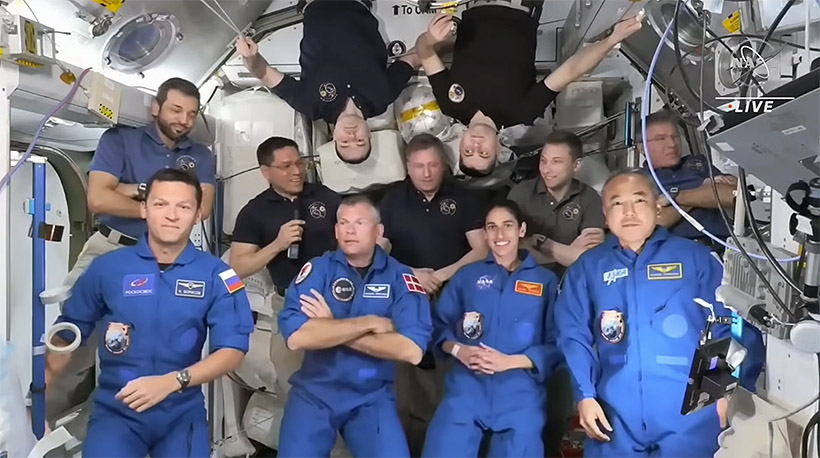
SpaceX Crew dragon which was carrying the NASA Expedition 70 crew, named Endurance by NASA, docked to International Space Station at 9:16 am EDT on Sunday, August 27, 2023. A bit later on same day at 10:58 am EDT after going through all the pressurising protocoles, the hatch of mating adaptor between Endurance Crew Dragon and the International Space Station (ISS) was opened. Soon the crew left the SpaceX crew dragon module to exit into the ISS harmony module.
Crew Dragon was carrying total four crew members of Crew-7 (Expedition 70) mission. As soon as the Crew-7 members joined their crewmates at ISS, the total population of ISS increased to 11. These include astronauts from five different countries.
The crew members of Crew-7 mission included Andreas Mogensen from European Space Agency (ESA), Jasmin Moghbeli from NASA, Konstantin Borisov from Russian space agency Roscosmos and finally the Satoshi Furukawa from Japan Aerospace Exploration Agency (JAXA).
The Crew-6 (Expedition 69) Astronauts are still at ISS, they welcomed the Expedition 70 astronauts. Shortly, within few days, the Expedition 69 astronauts will return back. The astronauts of Expedition 69 (NASA SpaceX Crew-6) mission include Stephen Bowen, Woody Hoburg, Frank Rubio and Sultan Al Neyadi from United Arab Emirates (UAE).
Now as the Expedition 70 have already reached the ISS, they will takeover charge of some of duties on with days and then it will be time to for Expedition 69 crew (NASA SpaceX Crew-6 Mission Crew) to return. The final date of return has not been decided but always as soon as the next expedition reaches ISS, it is considered to be the return time of previous expedition within one to two week. Crew of each mission spends roughly six months on ISS. During the stay the crew members perform different tasks which include working on the experiments going on on space station as well as maintenance of ISS as well.
The maintenance tasks of ISS sometimes include the spacewalks. These spacewalks involve suiting up in a special pressurised space suits, getting out of ISS and perform different required maintenance tasks. In a few upcoming days, when the Crew-6 Dragon module will undock itself from the ISS, we will keep you updated with the turn of events.
More about NASA SpaceX Crew Missions
Long time ago NASA used to utilize their Space Shuttle Program to transport the crew and the cargo to and from the International Space Station(ISS). The space shuttle program used to have involved a space shuttle (a reusable spacecraft), which used to be launched with the help of rocket and boosters. However, it used to make a comeback to earth by itself and make a landing like an airplane. The space shuttle program ran from 1981 onwards and it was retired in 2011. During this time the space shuttle program seen its fair share of successes and failures.
After the space shuttle program was retired in 2011, United States did not had any alternate inhouse arrangements to send the astronauts and supplies to the ISS and back for the long time. So Russia helped in this regard. Since then the NASA astronauts and many partners have been being launched for ISS missions using the Roscosmos Soyuz spacecraft.
However, much later a private venture called SpaceX came to the scene. Where Elon Musk, the founder pushed hard to experiment with the rocket technology and make the most parts of rockets reusable to cut costs. At first he failed to achieve much but with persistence, later on SpaceX got able to launch the rockets and land their boosters and first stages back to earth.
After seeing few successful attempts NASA contacted with SpaceX for some collaborations on launches. However, much later, SpaceX had a Crew transportation spacecraft ready. SpaceX called this spacecraft Dragon Spacecraft. Firstly on Demo 1 mission, instead of real humans an Anthropomorphic Test Device (ATD) was loaded into the space craft. This was a test mission, it launched into space, gone and docked with the ISS successfully on March 3, 2019. Later undocked successfully and as per planed it came back to earth and splashed into the sea. During the flight all kinds of systems, including the approach and docking with the ISS were tested.
After success of Demo-1, SpaceX and NASA had now enough confidence to send the real humans aboard the Dragon Spacecraft. A mission called Crew Dragon Demo 2 was launched on May 30, 2020. This mission had real human crew aboard the SpaceX Dragon Spacecraft. The crew included the Spacecraft commander Douglas Hurley and joint operations commander Robert Behnken. There was a backup crew member as well, Kjell Lindgren, however, he did not ended up on the flight. Crew Dragon Demo-2 mission not only successfully launched, it docked with ISS, undocked later on and splashed back to ocean as per planned.
After two successful demo crew missions, now NASA uses the SpaceX Dragon spacecrafts regularly to send astronauts and supplies to the ISS. So there are missions in which SpaceX Dragon spacecrafts are used to just send the supplies to ISS, these are called NASA SpaceX Commercial Resupply missions. There are other missions on which actual astronauts travel, these missions are called NASA SpaceX Crew mission.
There have been 7 crewed mission aboard SpaceX spacecraft. NASA now uses SpaceX dragons as primary means of transportation to and from ISS, as they are much less costly then using the Soyuz spacecraft of Russia’s Roscosmos, which they used to utilize after the space shuttle program and before SpaceX Dragon Spacecrafts.